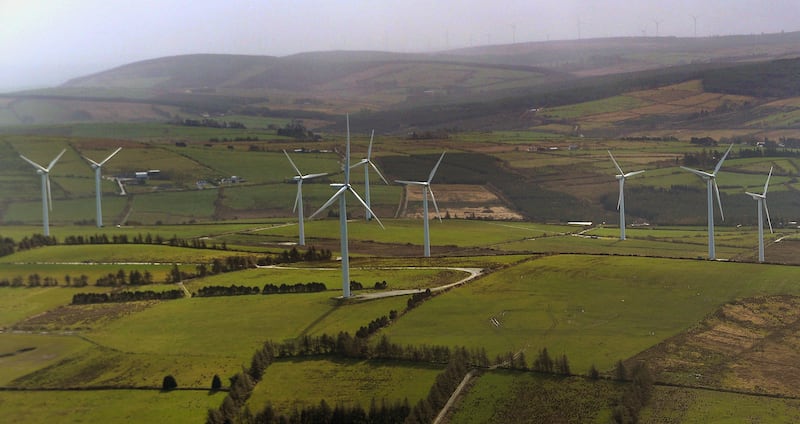As it confronts an unprecedented energy challenge, Europe must transition to a renewables-dependent energy system with a supergrid incorporating offshore wind as a central element, according to a new analysis by technology development company SuperNode.
The continent, and Ireland, it concludes, has to face up to the reality it will be “a weather-dependent power system”, and a new pan-European independent electricity system operator will be needed for it to be effective.
The scale of the task is indicated by a current scenario where grid infrastructure and grid technology are not fit for purpose.
The in-depth analysis by Irish entrepreneur Eddie O’Connor, SuperNode chief executive John Fitzgerald and Christian Kjaer, SuperNode’s chief public affairs officer, is published in the latest issue of the European Energy & Climate Journal.
READ MORE
Europe needs an independent system operator similar to the Midcontinent Independent System Operator (MISO) in the United States, which “is entirely privately driven and established as an independent non-profit organisation that delivers power across 15 states and Manitoba in Canada”, they argue.
As decarbonisation is an ambition shared by the EU’s closest neighbours – the UK, Norway and north African countries – “they must be closely involved in the process of planning, deploying and operating tomorrow’s offshore grids”.
The approach reinforced by a new European governance system will be essential to meeting EU energy needs and climate goals, they suggest. This “will also require dramatically increased power system capability and flexibility provided for by increased interconnection and innovative grid infrastructure – not least in the offshore space where no grids exist today”.

“However, the introduction of renewables at the speed necessary presents considerable challenges, most notably on the electricity grid. Grid technology and infrastructure are far from where they need to be to accommodate the needed level of renewables, especially in the offshore space where no grid currently exists,” they add.
A more holistic approach to grid planning is required with lessons drawn from MISO, which delivers significant cost savings, they conclude. A European-wide supergrid including a significant offshore grid could provide similar benefits though structured differently.
This would connect the best offshore renewables to demand centres across the continent, with offshore wind concentrated in northwest Europe and solar dominant around the Mediterranean – the greatest need for electricity exists in mainland EU where most Europeans live.
“Europe is applying a national approach to cross-border infrastructure planning and we are slowly – very slowly – moving towards a regional approach,” the authors note. But planning, developing and operating such a grid would face institutional barriers and would require a complex new European governing framework, they believe.
EU climate targets require accelerated deployment of renewables. During this decade alone, installation of solar and wind capacity needs to double compared to 2011-2020. Meanwhile, electricity must play a far greater role in decarbonising the heating, cooling and transport sectors.
While solar and wind power are the cheapest and most environmentally benign ways of producing electricity, “the rate and scale of their deployment will be decisive for whether the EU can achieve its energy transition . . . the benefits of the cheap renewable resource will be lost if the power cannot flow freely throughout Europe,” they warn.
Solar and wind generation can be deployed quickly but requires adaptation of existing grids and deployment of new infrastructure. “Establishing a European offshore renewable supergrid that can connect consumers throughout the region to the vast offshore renewable energy resource, while serving as interconnectors to support the internal energy market is vital.
“Dramatically increased power system capability and flexibility provided for by increased interconnection and innovative grid infrastructure are needed; not least in the offshore space.”

SuperNode was set up by renewables entrepreneur O’Connor to determine how super conductors could be used to rapidly transmit power with low losses in a large grid. It is co-owned by Norwegian green investment group AKER Horizons.
“Building an offshore grid would require significantly increased co-ordination between Europe’s nations and a changed governance structure, if we are to fully reap the environmental and economic benefits of a much-needed European-wide approach to electricity infrastructure investments,” the group says.
The European Commission estimates that two-thirds of the €800 billion investment in future EU offshore renewables will go towards offshore grid infrastructure and a third for power generation.
The EU has reduced its emissions by a quarter since 1990. Over the coming three decades it must reduce the remaining 75 per cent to meet Paris Agreement targets – energy accounts for 75 per cent of emissions. The EU27 have committed to climate neutrality by 2050, while reducing net emissions by at least 55 per cent before 2030.
“This requires a transformation of Europe’s energy sectors unparalleled with anything in history in terms of scale, impact and pace,” the authors say.
In addition, a carbon-free electricity supply combined with electrification of the heating and transport sectors to the greatest extent practicable are “preconditions for decarbonising Europe’s economies”.
The EU27 renewable energy share was 10.2 per cent in 2005, increasing steadily to 19.7 per cent in 2019, while the share of renewables in the electricity sector increased from 16.4 to 34.1 per cent and renewable electricity production doubled to more than 1,000 terawatt hours in 2019. Despite this golden period of renewable electricity growth, electricity’s share of overall EU gross final energy consumption has remained unchanged at 24 per cent for the past 15 years.
“It needs to more than double to reach the EU decarbonisation objectives. Moreover, large amounts of electricity will be needed to produce hydrogen and hydrogen-derived fuels in hard-to-abate sectors such as aviation, shipping and industrial processes,” they underline.
“Europe has all the prerequisites to make the necessary transition towards a decarbonised economy, based on renewable electricity. Capital is accessible at historically low rates; affordable renewable electricity generation technologies are available in abundance in the form of solar power, onshore and offshore wind; and we can process data at unprecedented speed.”
Whether Europe manages to build out its electricity infrastructure in time will be the main determinant of its ability to decarbonise its economies in a cost-efficient manner, they say. Today, the free exchange of electricity through cross-border interconnectors is still heavily restricted “and we are already witnessing increasing curtailment as peak wind and solar production cannot reach the customer due to grid constraints. This will be exacerbated by the variable nature of renewables and growth in electricity demand.”
Realising a grid sufficiently robust to service deployment of the vast increase in renewables revolves around many institutional issues “not sufficiently established in the EU”. This includes creating a European-wide multilateral governing body; designing, building and operating the offshore infrastructure; establishing principles for ownership and appointing a European-wide regulator. It also requires financing the infrastructure, establishing a tariff regime and a governance structure for co-ordinating with neighbouring countries.
The commission has set out a more holistic approach to an offshore system operation, the authors note, where “the relevant group of TSOs [transmission system operators] could appoint one TSO to manage the entire offshore area (possibly consisting of several offshore bidding zones)”.
A European independent system operator (EISO) is the model used for gas infrastructure in the North Sea.
It would mean member states or relevant system operators setting up an ISO together to develop and operate offshore assets in a well-co-ordinated manner, including managing the bidding zone and ensuring operational security. Commercial parties would own the infrastructure and receive a regulated return, the SuperNode team recommend.
Responding to the commission, currENT, the association of companies promoting innovative grid technologies, said: “It is these types of regulatory reform that are needed for Europe to reach its moon-shot attempt at reaching decarbonisation in due time. Unfortunately, these policy options from the impact assessment are not adequately reflected in the commission’s proposal [on trans-European networks for energy, known as TEN-E] when it comes to the offshore space.”
MISO’s mission is to “work collaboratively and transparently with our stakeholders to enable reliable delivery of low-cost energy through efficient, innovative operations and planning”. It has $22 billion (€20.9 billion) in gross market energy transactions annually and covers 42 million customers. It creates value for members through improved reliability, more efficient use of existing assets and reduced need for additional assets, the paper confirms.
The EISO could be mandated to identify available renewable energy resources; to spell out infrastructure gaps and estimate power requirements over short, medium and longer-term horizons, they suggest. “It must also be granted access to all relevant information and data necessary for operating, maintaining and developing the offshore infrastructure.”
It should also establish a research and innovation programme to ensure European industry develops the best and most innovative solutions for both domestic use and exports. In time, the authors suggest, the EISO would be tasked with developing and operating the pan-European grid to meet the needs of participating TSOs and countries.
US researchers have found that via a national approach rather than a state-by-state one, emission reduction goals could be met with 30 per cent fewer renewables by building assets in the best locations and transmitting electricity to where it is needed, through a unified, national grid.
“Europe’s current, national or regional trial-and-error approach to building offshore infrastructure risks is proving prohibitively expensive for Europe’s economies, requiring far more investments in both grid and renewable energy production assets than needed,” the SuperNode team conclude.
Benefits from co-ordinating offshore grid connections in the North Sea have been identified by Imperial College London researchers. They found large cost savings from co-ordinating offshore connections to offshore hubs (€27 billion to €53 billion) and additional savings from integrating the offshore grid with UK and EU and Norwegian networks – a further saving of some €29 billion.
The SuperNode analysis reinforces that view: “It is very much in the interests of Norway, the UK, northern African nations and the EU to jointly plan and become integral parts of a more interconnected European multilateral framework, to be able to both exchange and to balance their electricity generation.”














